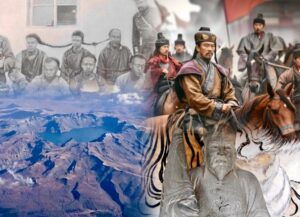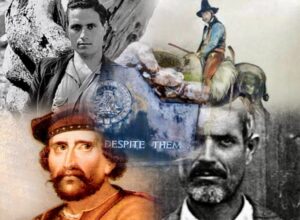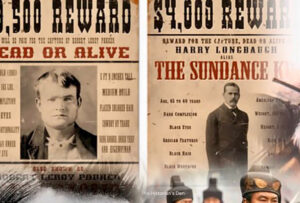Aron Anderson and Doug Stoup were dropped at the Leverett Glacier. Solo Sébastien Lapierre started at Hercules Inlet, the route where the skiers are covering 30+ km per day, in particular Johanna Davidsson
This year a strong team of solo (unassisted) skiers are on the Hercules Inlet route, judging the daily distances they cover. Johanna is already covering more than 30 km per day. Sébastien started off with 25 km per day. Risto, with double the load, also covers around 25. The Polish lady is getting into her rhythm. The British Army Reservists are breaking 30 km per day.
Doug Stoup, a strong skier himself, and adaptive sit-skier, Aron Anderson, started at the bottom of the Leverett Glacier. This route is about half the distance of the Hercules Inlet route. As a child Aron got cancer. When he was 9 years old, he underwent surgery and ended up in a wheelchair, but Aaron “took an early decision not to allow the wheelchair to stop him, but instead sees what opportunities it could provide.” Among other achievements, Aron participated in 4 Paralympics in 3 different sports. More, and his fundraising here.
Interactive Map: Antarctica Skiing Routes
2016-17 Antarctica Ski Expedition List – updated
Rerun – AdventureStats Special: What is Solo?
Hercules Inlet start point unassisted to the Pole
Risto Hallikainen: In the previous post we reported that, looking at Risto’s tracker, it seems as if he made a depot. But Vesa from his Finland home team reported to Exweb that Risto plans to leave his first depot at 84 degrees. Latest position: Dec. 2, 2016, 2:49:30 PM UTC, Elevation: 1,074.61 m, Lat: 82.935640 Lon: 080.181741, after three hours skiing this morning. Editor’s Note: If Risto leave depots for his return, taking food out of his sled, it has no effect on his solo status. As long as no one else drops food for him, he is still solo unassisted for the duration of the whole return journey.
Sébastien Lapierre: The French Canadian covered great distances out of Hercules Inlet. It seems as if Sébastien was dropped off in the afternoon of November 28 in a balmy -15ºC. On November 30th he reported a “big day of 24,67 km! Not easy because there was no sun so no contrast on the snow.” Yesterday he covered even a bit more miles, 25,2 km despite the white-out. Sébastien completed the detour to avoid the crevasses and today he is heading South. Position Dec 2, 2016, 3:44:00 PM UTC Elevation: 2,595.18 ft. Lat: 80.766570 Lon: 080.026603.
Johanna Davidson: The Swedish lady is gliding on. She reported yesterday, “On the morning of day 17 the sun is still out but the clouds might be coming in with some bad visibility. So I am enjoying the sweet sun while it is still with me. It is going well, I am feeling very good and I am so happy to be here and the last three days I have been doing like 30 kilometers, so it is way faster then I thought.” Covering 33.4 km yesterday, Johanna crossed into 83 degrees. Lat: 83.320860 Lon: 080.088121.
Małgorzata Wojtaczka. The Polish lady passed the mountains and is now left with the endless white horizons in front of her. She experienced some hours without wind, only complete silence, and described it as, a “weird feeling. Somehow something is missing, as if someone had turned off the radio.” Position: Dec. 2, 2016, 16:00:00 UTC 081° 17.039S, 080° 18.995W at 768m above sea level.
Lou Rudd (leader), Oliver Stoten, Chris Brooke, Alex Brazier, Alun George and James Facer-Childs: The Army Reservists covered 16.8 nautical miles yesterday (31.1 km) in their 10-hour routine. They aim to cross into 84 degrees today. The forecast doesn’t look great though for the next couple of days, reported the men, “it looks like we’re going to lose the sun, and we’re going to be hit with a lot of low cloud and mist which will make reading the ground very difficult so it probably will slow progress a bit.” They described their daytime routine:
“Once we’re out of the tents, we’re pretty strict that everybody is packed up, harnesses on, clipped into skis, and ready to go bang on the dot for 9 o’clock in the morning. I’m quite strict about that so that everybody knows people aren’t hanging around unnecessarily and getting cold. Everybody can take their jackets off at the same time, and be ready to go. And we head off. So, we’re moving by nine, and the we ski non-stop, we now do 70 minutes. We ski in single file, one behind the other. The lead guy, he’s got a compass set into a hands-free frame on his chest, he’s responsible for navigating, in as straight a line as possible, so we’re nice and efficient skiing along. He’s also responsible for time-keeping, and also for crevasse-spotting as well. So for the guy in the lead is very busy and there’s a lot going on. And he really needs to concentrate when he’s up front. So he’ll ski for 70 minutes, the rest of us following on behind, and just short of 70 minutes, he’ll wave his ski sticks in the air in a crossed motion, to indicate that we’re about to stop and as he does that, he’ll then stop. We’ll pull up alongside each other for the break and the change over.”
“The way it works for the break, as soon as you pull up, you turn around on your skis, shuffle back to your pulk, and pull your down jacket, a big warm goose down jacket, straight out of the front of the pulk, whoop that on straightaway because the loss of body heat is pretty instantaneous the minute you stop. So we get that on, it’s a quick drink out of the flask, quick check everyone’s ok, a mouth full of food, jacket off, hand over the compass, change over the lead guy. The leader then drops onto the back of the train and we head off again. And we’ve got our stops down to about six or seven minutes now, which is really good. And then we’re off again for another 70 minutes, and we roll through that, non-stop, for ten hours and we go straight through to 7 o’clock in the evening and that pretty much the routine. By being really disciplined and strict with that, I think it’s really helped us in our progress and getting even quicker with the mileage.”
Fuchs-Messner start point unassisted to the Pole
Ryan Waters (US) guiding for Mountain Professionals: Katrina Follows (England, lives in Chamonix), Paul Adams (USA) and Scott Kress (CA): Most the days have looked similar, reported Ryan. “The endless white in all 360 degrees, with subtle wind features dotting the surface, and the occasional uphill trending terrain that we can pick up visually.” On Nov. 28 they broke the 11 Nautical Miles [20 km] in a day, during 7 one-hour skiing blocks separated by a mere 10-minute break each time. “When we reached our location to stop for the day, we peared to the east out on the horizon and saw mountains! Most likely the western edge of the Pensacola Range. It is quite beautiful out here in its own harsh way, to look over and see those lonesome mountains was powerful.” The team crossed 84 degrees yesterday. Kat reported colder temperatures and today they will start with their first 8-hour skiing days.
Carl Alvey guiding for ALE, Bob Maxwell: no new news. There is no indication if they are unassisted, or if they get resupplies.
Novolazarevskaya start point, unassisted kite-support
Michele Pontrandolfo’s tracker gives his position as Thu, Dec 1, 2016 3:46 PM UTC Lat: 71.240976 Lon: 011.196991
Leverett Glacier start point unassisted
Guide Doug Stoup (US) and adaptive Swedish skier Aron Anderson started their expedition on December 1, after waiting for 3 days at Union Glacier for favorable weather to land at the Ross Ice Shelf. The Twin Otter flight took 4 hours. They strated right away, and skied 2.5 hours in “glorious” weather with almost no wind, reported Aron. “All this time I am struck by how beautiful it is here. Absolutely magical! It feels too extra cool that we’re all alone out here in the middle of nowhere, me and Doug. Just us and the snow!”
Hercules Inlet to South Pole – emergency assisted
Emma Kelty: no news
Follow team blogs in the Dispatch stream on pythom.com
South Pole 2016-17 Interviews on Explorersweb/Pythom:
Eric Philips, South Pole 2016-17 New Start Point attempt (Interview)
Exweb South Pole Interview with Johanna Davidsson: kite return attempt
Cycle Antarctica: Hank van Weelden Pole to Coast attempt (Interview)
[UPDATE 2] Risto Hallikainen, solo South Pole return ski attempt (Interview)
1989: Arved Fuchs traversed Antarctica, with Messner (Interview)
Ryan Waters to guide Fuchs-Messner route (Antarctica 2016-17 interview)
Canadian Sébastien Lapierre to attempt solo ski to South Pole (Interview)
Emma Kelty: speed ski and return attempt (Exweb South Pole interview)
Previous/Related on Explorersweb/Pythom:
Higher Sastrugi and stronger headwinds in 82ºS – Antarctica update
Antarctica Current: Polar How-To-Guide Heads-Up
Explorers House map with interactive South Pole ski routes
HumanEdgeTech Expedition Technology (e.g.CONTACT software)
Rerun – AdventureStats Special: What is Solo?
AdventureStats.com for Polar Statistics and Rules. Note that a solo claim has to be unassisted,
therefore no supplies carried by pilots or car drivers, or anything (food, fuel, etc) received from any person along the way. A solo person may be wind supported (kites/sails). Claiming to have ‘skied to the Pole’, a full route (from a coastal start point) has to be completed, without flying part of the route.
1 nautical mile = 1,852 km
Hercules Inlet is located at 80°S near Union Glacier, 1130 km from the Geographic South Pole.
The Fuchs-Messner start is 890 km in a straight line from the Pole.
Novolazarevskaya to South Pole of Inaccessibility (POI) is 1610 km in a straight line.
South Pole of Inaccessibility (POI):
2011-12 position: S82°06.696, E055°01.951 (Copeland/McNair-Landry)
On Dec. 14, 2014 Frédéric Dion reported the position the POI (at Lenin’s bust) as S82º 06.702′ E55º 2.087′ at an elevation of 3741 m.
Geographic South Pole (GSP): 90 degrees South
Gateway port Cape Town, South Africa:
To ALCI /TAC base camp Novolazarevskaya / Novo
70° 46’37”S, 011° 49’26”E
Gateway port Punta Arenas, Chile, South America:
To ALE base camp, Union Glacier
79° 45’S, 083° 14’W elev 708m
Lat: -79.760591 Lon: -82.856698
Weather:
https://www.yr.no/place/Antarctica/Other/Union_Glacier/
ALE Union Glacier weather cam 79º 46’S, 83º 16”W
South Pole webcam 90ºS
#polar #antarctica #Southpole #thepoles #skisouthpole






